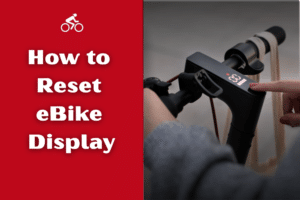If you ride an e-bike often, knowing how to test e-bike battery health can save you from surprise breakdowns and costly replacements.
The process is simple, and with just a multimeter and a few minutes, you can find out if your battery is still strong or starting to wear out.
Key Summary:
To test an e-bike battery, first charge it fully, then use a digital multimeter set to DC voltage. Place the red probe on the positive terminal and the black probe on the negative. A healthy battery should read close to its rated full-charge level (for example, ~54.6V for a 48V battery). If the reading is much lower, drops quickly under load, or the battery fails to charge properly, it may be nearing the end of its life.
Why Testing Your E-Bike Battery Matters
E-bike batteries aren’t cheap, and when they stop performing well, it can really mess with your rides. Maybe your bike isn’t going as far as it used to. Maybe it’s taking longer to charge or cuts off unexpectedly. These are all signs that something might be off with the battery.
Testing your battery once in a while helps you catch small problems early, before they become big ones. It can tell you if a cell is weak, if the battery is no longer holding a full charge, or if there’s something off with the connection.
And sometimes, it’s not even the battery. A loose terminal, a bad charger, or even just an inaccurate display reading can make it look like the battery’s dying. A quick test can help you figure out what’s really going on.
Bottom line, if you rely on your e-bike regularly, knowing how to test the battery is just a handy skill to have. You don’t need to be an electrician to do it, either.
Tools You’ll Need For Testing
You don’t need a fancy toolkit to test your e-bike battery. Just a few simple tools will do the job:
- Digital multimeter (for checking voltage, current, and resistance)
- Load tester (optional, but useful for deeper testing)
- Safety gloves (just in case)
- Notebook or app to track your test results
How To Test An E-Bike Battery Using A Multimeter
To test an e-bike battery:
- Fully charge the battery
- Set your multimeter to DC voltage
- Connect the red and black probes to the positive and negative terminals
- Read the voltage display
- Compare the reading to the expected voltage range
Quick things to keep in mind:
- Always test after a full charge
- Know your battery’s rated voltage (usually 36V, 48V, or 52V)
- A reading much lower than expected might mean the battery is failing
Now, if you’re ready to roll up your sleeves, here’s how to do it step by step.
1. Fully Charge The Battery
Start by charging your battery all the way up. You want to test it at 100% so you get a clear picture of how it’s doing. Don’t skip this part; testing a half-charged battery won’t tell you much.
Some e-bikes have a light or display that shows when it’s fully charged. If not, just go by the usual charge time and let it sit for an extra 30 minutes to top off.
2. Set Your Multimeter To DC Voltage
Grab your multimeter and turn the dial to DC voltage (you’ll usually see a “V” with a solid line and dashed line underneath). Most e-bike batteries fall between 24V and 52V, so pick a setting slightly above your battery’s rating.
For example, if you have a 48V battery, set it to 60V or the next highest option.
3. Connect The Probes To The Battery Terminals
Take the red probe and touch it to the positive terminal, then take the black probe and touch the negative one. Make sure the probes are steady and not slipping around. You want a clean connection for a good reading.
You can usually find the terminals on the battery case or through the charging port. Just be gentle, especially if the connectors are small or exposed.
4. Read The Voltage On The Display
Your multimeter will now show a number. This is your battery’s voltage.
Compare that number to what your battery is supposed to be when fully charged. A healthy 48V battery, for example, might show around 54.6V. If the number is significantly lower, say, under 50V, there might be a problem with one or more cells inside.
It’s also a good idea to write this number down so you can keep track over time.
5. Repeat The Test After A Short Ride (Optional)
If you want to go a step further, take the bike for a quick 5–10 minute ride and then test the voltage again.
This gives you a sense of how quickly the battery drops under light use. If you see a big drop, that could mean the battery is struggling to hold a charge.
How To Do A Basic E-Bike Battery Load Test
A load test gives you a better idea of how your battery performs under pressure, kind of like seeing how your legs feel biking up a hill, not just standing still.
Here’s how you can do a simple version of a load test:
- Use a resistive load like a light bulb or heating element: Attach a known load to the battery terminals. Something like a 12V or 24V car bulb (depending on your battery type) works well. It simulates real-world demand without needing specialized tools.
- Measure the voltage before and during the load: First, record the voltage with just the multimeter. Then connect the load and watch what happens to the voltage. A small drop is normal, but a sharp drop could mean the battery is losing capacity.
- Track how long it holds up: If the voltage falls quickly or the light dims fast, that’s usually a red flag. A healthy battery should be able to power a light or small load steadily for several minutes without major voltage sag.
Additional Ways To Assess Battery Health

Besides multimeter and load tests, there are a few other ways to get a clearer picture of your battery’s condition.
Using A Smart Charger Or BMS
Some chargers come with built-in displays that show voltage, charge rate, and battery condition. They’re plug-and-play and make things easy if you’re not into manual testing.
A Battery Management System (BMS), if your battery has one, can also offer insights like individual cell voltage, state of charge, and error messages. Many modern e-bike batteries have BMS systems built in, and some even connect via Bluetooth to a phone app.
If your battery has this feature, take advantage of it. It’s like having a mechanic living inside the battery, quietly keeping tabs.
Doing A Real-World Road Test
You can also get a feel for battery health by just riding.
Take your bike on a familiar route and pay attention to how it behaves:
- Does the power cut off earlier than usual?
- Is it struggling on hills where it used to glide?
- Do you get the range you expected?
Compare this with past rides. A drop in range, even when fully charged, usually means the battery is wearing down.
Monitoring Charge And Depletion Time
Track how long your battery takes to charge and how quickly it depletes during a normal ride.
- Charging too fast or too slow can mean a problem with the charger or battery cells.
- Discharging quickly, especially under light riding, suggests the battery may no longer be holding full capacity.
Use a timer or a smart charger with tracking features. Over time, you’ll spot trends that tell you more than a single test ever could.
Signs Your E-Bike Battery May Be Failing
Your battery won’t just stop working one day out of the blue. It usually gives you a few clues along the way.
Here are some signs to watch out for:
- Reduced range. If your bike can’t go as far on a full charge as it used to, the battery may be wearing out.
- Sudden power cutoffs. Random shutoffs or surges during a ride can signal weak or damaged cells.
- Takes longer to charge. If your regular charger suddenly takes way more time, the battery might be losing efficiency.
- Swelling or heat during charging. This is a serious red flag. Stop using the battery and check for visible damage.
- Voltage readings are lower than they should be. A fully charged 48V battery showing under 50V could mean it’s near the end of its lifespan.
How To Maintain Your Battery For Better Performance
Good battery care goes a long way. It doesn’t take much, just a few regular habits that help it stay healthy longer.
- Don’t let it drain to zero. Try to keep it above 20 to 30 percent. Fully draining lithium-ion batteries shortens their life.
- Charge it after every ride if possible. Topping it up regularly is better than full-drain cycles. Just don’t leave it on the charger for days.
- Store it in a cool, dry place. Avoid extreme heat or cold. A garage in summer or winter might not be the best spot.
- Keep the terminals clean. Use a soft cloth to wipe off any grime or corrosion. Dirty connections can cause false readings.
- Use the right charger. Stick to the one that came with the bike or a verified replacement. Using the wrong charger can mess with the battery’s internal electronics.
- If you won’t ride for a while, store it half-charged. Long-term storage at full or empty can stress the battery. Aim for around 50 percent and check it every month or two.
When To Replace Your E-Bike Battery
No battery lasts forever. Most e-bike batteries can handle around 500 to 1000 full charge cycles. That means if you ride and charge your bike regularly, it may start showing signs of wear after a couple of years.
You might notice your bike doesn’t go as far on a full charge or takes longer to power up. Maybe the battery drops voltage quickly after just a short ride. If you’ve tested it and the voltage is low even after a full charge, or if it won’t hold a charge at all, that’s a pretty clear sign it’s time for a new one.
It’s also smart to check with your battery’s manufacturer. Some offer tools or apps to monitor battery health, and others might offer replacement programs or advice tailored to your model.
Final Words
Knowing how to test your e-bike battery can save you time, money, and frustration. A quick voltage check with a multimeter or a simple load test can tell you if your battery is working like it should or is starting to wear out.
With regular maintenance, smart charging habits, and a little bit of attention, you can keep your battery healthy and enjoy more worry-free rides.
FAQs
How often should I test my e-bike battery?
If you ride regularly, test it every couple of months. If you’re noticing any drop in range or weird behavior, test it right away.
Can I test an e-bike battery without removing it?
Yes, if your battery has exposed terminals or a port where you can safely connect a multimeter. But for best results, especially when doing a full test, it’s better to remove it.
Is it safe to use a cheap multimeter?
You can use a budget-friendly multimeter, but make sure it’s working properly. Inaccurate readings can throw you off, so it’s worth spending a bit more for something reliable.
Why does my fully charged battery show low voltage?
This could mean the battery cells are starting to fail. It might also be a sign of poor charging, a faulty charger, or high internal resistance in the battery.
What’s the safest way to dispose of a dead e-bike battery?
Take it to a local recycling center or bike shop that accepts lithium batteries. Never toss it in the trash, it’s a fire hazard and harmful to the environment.
Al Amin Morshed is the founder of BoltBikers and a seasoned e-bike reviewer with years of hands-on experience testing electric bikes. As a long-time e-bike enthusiast, he combines real-world riding insights with in-depth research to create honest, helpful content for riders of all levels. Through BoltBikers, Morshed aims to make e-biking more accessible, practical, and enjoyable – whether you’re a new rider or a daily commuter looking for the best gear.








